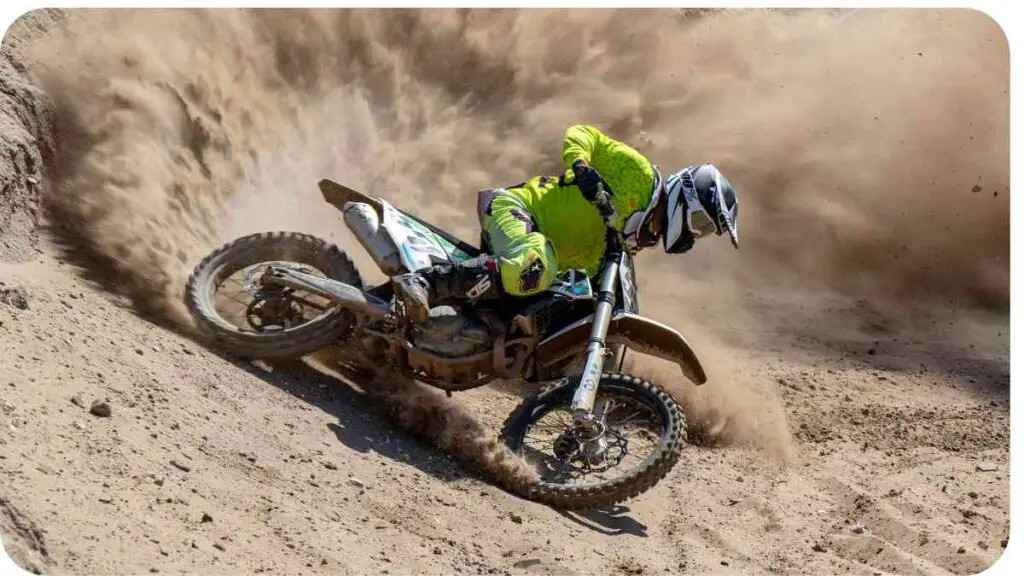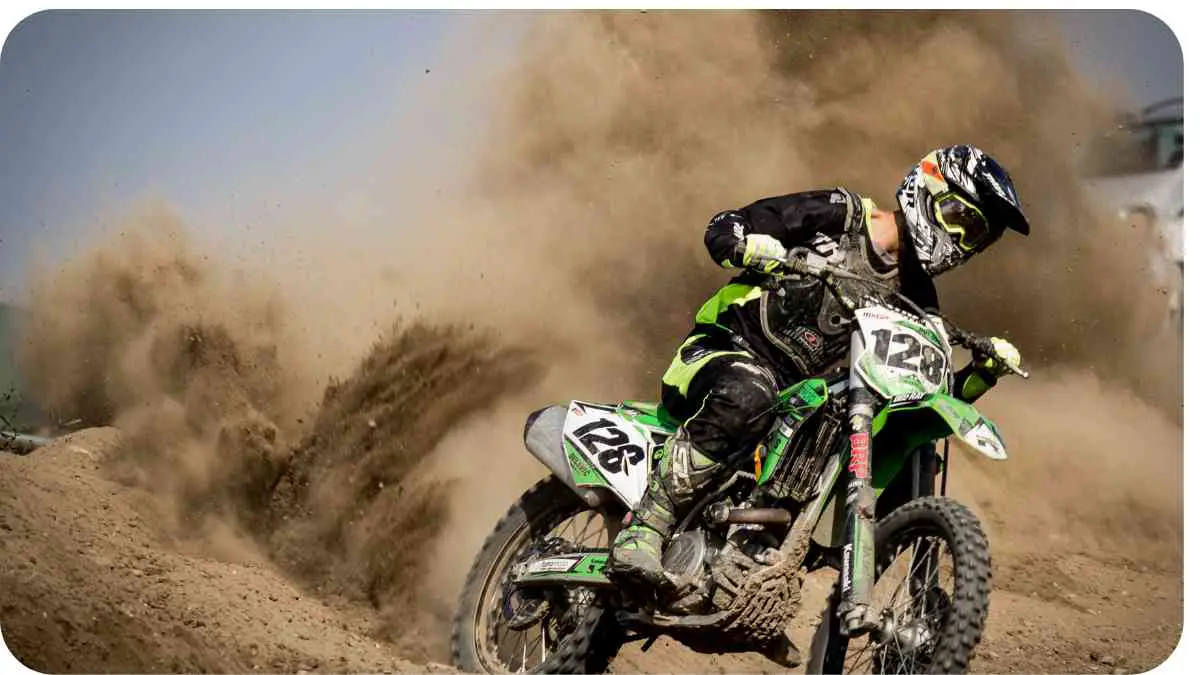If you’ve noticed a sudden drop in power on your dirt bike, fear not! In this comprehensive guide, we’ll delve into the common issues causing power loss and equip you with a troubleshooting plan to revitalize your ride. Let’s kickstart this journey by understanding the primary culprits behind a lack of power.
| Takeaway |
|---|
| Identify fuel system issues by checking for symptoms like sputtering or poor acceleration. Clean or replace the fuel filter and adjust carburetor settings accordingly. |
| Address ignition system problems by inspecting and replacing the spark plug, adjusting ignition timing, and testing the ignition coil and wiring harness. |
| Ensure a clear air intake by regularly cleaning or replacing the air filter and inspecting air passages, intake manifold, and airbox for any issues. |
| Maintain a free-flowing exhaust system by checking for blockages, repairing or replacing damaged components, and fixing any exhaust leaks. |
| Monitor engine compression through regular tests and address issues such as low compression, leaking cylinder head gaskets, worn piston rings, or faulty valve seals. |
| Keep the transmission and clutch in optimal condition by replacing worn clutch plates, checking and replacing transmission fluid, maintaining the clutch cable, and addressing gearbox malfunctions. |
| Pay attention to the spark plug’s condition, ensuring it is not fouled or improperly gapped, and address issues of overheating or insufficient spark. |
| Tune the carburetor correctly by adjusting the air-fuel mixture, carburetor jetting, idle speed, and resolving any choke problems. |
| Perform regular maintenance, including oil changes, air filter cleaning, chain and sprocket inspections, cooling system checks, and brake maintenance, to prevent power loss. |
| If troubleshooting fails, seek professional mechanic consultation for more complex issues affecting power loss in your dirt bike. |
2. Common Causes of Power Loss
2.1 Fuel System Issues
Fuel-related problems are a frequent culprit when it comes to power loss. Below is a detailed table summarizing common fuel system issues and their troubleshooting tips.
When your dirt bike faces issues, comprehensive troubleshooting becomes crucial. Learn to identify and fix common problems with this step-by-step guide.
Table: Fuel System Troubleshooting
| Issue | Symptoms | Troubleshooting Tips |
|---|---|---|
| Clogged Fuel Filter | Sputtering engine, lack of power | – Replace the fuel filter |
| Incorrect Fuel Mixture | Poor acceleration, overheating | – Adjust carburetor settings |
| Fuel Pump Malfunction | Engine stalls, rough idling | – Test and replace the fuel pump |
| Air Leaks in the System | High RPMs when idle, erratic performance | – Inspect and replace faulty gaskets |
2.2 Ignition System Problems
The ignition system is another critical aspect influencing your dirt bike’s power output. Let’s explore common issues and effective troubleshooting techniques.
Off-road adventures can lead to punctured tires. Be prepared with the knowledge of fixing a punctured off-road tire using a step-by-step guide.
Table: Ignition System Troubleshooting
| Issue | Symptoms | Troubleshooting Tips |
|---|---|---|
| Faulty Spark Plug | Difficulty starting, misfires | – Inspect and replace the spark plug |
| Ignition Timing Issues | Poor performance, backfiring | – Adjust the ignition timing |
| Ignition Coil Problems | Stalling, engine hesitation | – Test and replace the ignition coil |
| Wiring Harness Troubles | Intermittent power loss, electrical issues | – Check for damaged wires and replace if necessary |
2.3 Air Intake Blockages
A clear air intake is vital for optimal engine performance. Let’s explore common issues related to air intake and how to troubleshoot them.
Table: Air Intake Troubleshooting
| Issue | Symptoms | Troubleshooting Tips |
|---|---|---|
| Dirty Air Filter | Reduced power, poor acceleration | – Clean or replace the air filter |
| Clogged Air Passages | Rough idling, decreased throttle response | – Inspect and clean air passages |
| Damaged Intake Manifold | Engine misfires, uneven power delivery | – Replace a damaged intake manifold |
| Airbox Issues | Whistling noise, irregular RPMs | – Ensure the airbox is sealed properly |
2.4 Exhaust System Restrictions
A free-flowing exhaust is essential for efficient engine performance. Let’s explore common exhaust system issues and how to troubleshoot them.
Winching is a crucial skill in off-roading. Ensure safety with these essential winching techniques and tips to make your off-road experiences worry-free
Table: Exhaust System Troubleshooting
| Issue | Symptoms | Troubleshooting Tips |
|---|---|---|
| Exhaust Pipe Blockages | Weak exhaust note, reduced power | – Inspect and remove any obstructions |
| Damaged Muffler | Excessive noise, decreased performance | – Replace or repair the damaged muffler |
| Catalytic Converter Issues | Engine overheating, poor acceleration | – Check and replace a faulty catalytic converter |
| Exhaust Leaks | Hissing sounds, decreased throttle response | – Inspect and fix any leaks in the exhaust system |
3. Engine Compression Problems

Optimal engine compression is crucial for power delivery. Let’s explore potential issues related to compression and how to troubleshoot them.
Table: Compression Issues Troubleshooting
| Issue | Symptoms | Troubleshooting Tips |
|---|---|---|
| Low Compression | Weak power output, difficulty starting | – Perform a compression test |
| Leaking Cylinder Head Gasket | Overheating, white smoke from exhaust | – Replace the cylinder head gasket |
| Piston Ring Wear | Excessive oil consumption, reduced power | – Inspect and replace worn piston rings |
| Valve Seals Malfunction | Blue smoke from exhaust, poor idling | – Check and replace faulty valve seals |
4. Transmission and Clutch Issues
Smooth transmission and clutch operation are crucial for maintaining power. Let’s explore potential problems and how to troubleshoot them.
Regular inspections are key to off-road vehicle reliability. Dive into a comprehensive guide on inspecting your off-road equipment, ensuring optimal performance on every adventure.
Table: Transmission and Clutch Troubleshooting
| Issue | Symptoms | Troubleshooting Tips |
|---|---|---|
| Worn Clutch Plates | Slipping clutch, poor power transfer | – Replace worn clutch plates |
| Transmission Fluid Issues | Gear shifting difficulties, strange noises | – Check and replace the transmission fluid |
| Clutch Cable Problems | Difficulty engaging/disengaging clutch | – Inspect and lubricate or replace the clutch cable |
| Gearbox Malfunctions | Difficulty changing gears, grinding noises | – Inspect and repair or replace the gearbox |
5. Spark Plug Condition

The spark plug plays a vital role in igniting the air-fuel mixture. Let’s explore how its condition can affect power output and how to troubleshoot related issues.
Enhance your off-road vehicle’s capabilities by upgrading its suspension. Learn the top tips and tricks to maximize performance and conquer diverse terrains with confidence.
Table: Spark Plug Troubleshooting
| Issue | Symptoms | Troubleshooting Tips |
|---|---|---|
| Fouled Spark Plug | Rough idling, poor acceleration | – Clean or replace the fouled spark plug |
| Incorrect Gap | Misfires, engine hesitation | – Adjust the spark plug gap to manufacturer’s specifications |
| Overheating | Blistered insulator, pre-ignition | – Check for proper heat range and replace if necessary |
| Insufficient Spark | Difficulty starting, weak power | – Inspect ignition system for faults |
6. Tuning and Carburetor Adjustment
Proper tuning and carburetor adjustment are key to optimizing your dirt bike’s performance. Let’s explore common issues and effective troubleshooting techniques.
Table: Carburetor Adjustment Tips
| Issue | Symptoms | Troubleshooting Tips |
|---|---|---|
| Rich Fuel Mixture | Black smoke from exhaust, poor fuel economy | – Adjust the air-fuel mixture screw |
| Lean Fuel Mixture | Engine overheating, poor acceleration | – Adjust the carburetor jetting |
| Idle Speed Adjustment | Stalling at idle, uneven idle RPMs | – Set the idle speed to the manufacturer’s specifications |
| Choke Problems | Difficulty starting, erratic performance | – Inspect and repair or replace the choke mechanism |
7. Regular Maintenance Tips
Preventive maintenance is crucial to ensuring consistent power delivery and a longer lifespan for your dirt bike. Here are some tips for maintaining optimal performance:
- Oil Changes: Regularly change the engine oil as per the manufacturer’s recommendations. Clean oil promotes smoother operation.
- Air Filter Cleaning: Keep the air filter clean and replace it if necessary. A clogged air filter restricts airflow, affecting performance.
- Chain and Sprocket Inspection: Ensure the chain is properly lubricated and adjust tension as needed. Worn-out sprockets or chains can impact power transfer.
- Cooling System Check: Maintain the proper coolant levels and check for any leaks. Overheating can lead to power loss.
- Brake Maintenance: Ensure your brakes are in top condition. Malfunctioning brakes can affect your ability to ride confidently and control power.
8. Professional Mechanic Consultation

If you’ve exhausted the troubleshooting steps and still face power loss issues, it’s advisable to consult a professional mechanic. They have the expertise and tools to diagnose and fix more complex problems.
9. Conclusion
Your dirt bike’s power loss can stem from various factors, but armed with this troubleshooting guide, you can systematically identify and address the issues. Regular maintenance and a keen eye for potential problems will keep your dirt bike performing at its peak.
Remember, a well-maintained bike not only ensures a thrilling ride but also extends the life of your beloved two-wheeled companion. Happy riding!
Further Reading
Here are some additional resources to further explore and enhance your understanding of dirt bike power loss and troubleshooting:
- BikeRelate – Maintenance and Troubleshooting: This comprehensive guide provides insights into maintaining and troubleshooting motorcycles, specifically addressing power loss at high RPM.
Description: Explore in-depth tips and solutions for resolving power loss issues, especially at high RPM, ensuring a smooth and powerful riding experience. - Champion Auto Parts – Diagnostic Center: Champion Auto Parts offers a diagnostic center focused on power sports, providing valuable information on addressing the loss of power in your motorcycle.
Description: Dive into a diagnostic center tailored for power sports, offering expert guidance on identifying and resolving power loss issues in your motorcycle. - Motorcycle Habit – 6 Reasons Your Motorcycle is Losing Power When Accelerating: Motorcycle Habit explores six common reasons motorcycles may lose power during acceleration, providing practical insights into troubleshooting and solutions.
Description: Uncover the six key factors that could be impacting your motorcycle’s power during acceleration and learn effective strategies for troubleshooting.
FAQs
Why is my dirt bike losing power suddenly?
Sudden power loss could be attributed to various factors, including fuel system issues, ignition problems, or air intake blockages. Refer to the respective sections in this guide for detailed troubleshooting steps.
How can I determine if my spark plug is causing power loss?
Inspect the spark plug for signs of fouling, adjust the gap, and ensure it’s within the manufacturer’s specifications. Refer to the Spark Plug Condition section for more details.
What role does the carburetor play in power loss?
The carburetor regulates the air-fuel mixture. If it’s improperly tuned or adjusted, it can lead to power loss. Check the Tuning and Carburetor Adjustment section for troubleshooting tips.
Is regular maintenance essential for preventing power loss?
Yes, regular maintenance, including oil changes, air filter cleaning, and overall system checks, is crucial for preventing power loss. Refer to the Regular Maintenance Tips section for detailed recommendations.
When should I seek professional help for power loss issues?
If you’ve followed the troubleshooting steps and the issue persists, consulting a professional mechanic is advisable. They can diagnose and address more complex problems that may be causing power loss.

Hi there! I’m Hellen James, and I’m the author of Unified Off-roads. I’ve been driving off-road for more than ten years, and I’ve had a lot of fun in that time—and a few not-so-great experiences too. But I’ve always wanted to help other people get started off-roading, so I decided to start this blog to share my knowledge with others.


